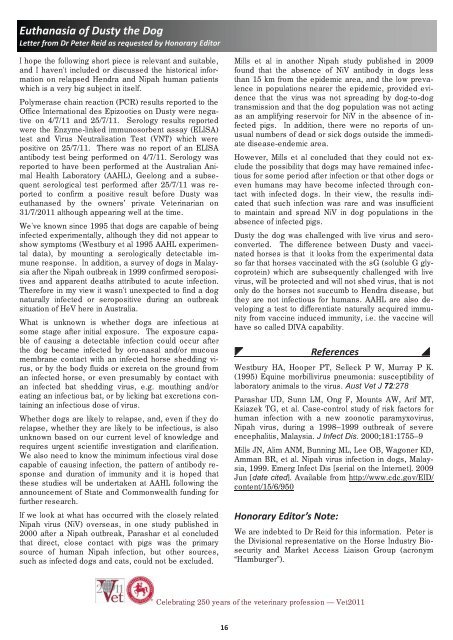September 2011 - Australian Veterinary Association
September 2011 - Australian Veterinary Association
September 2011 - Australian Veterinary Association
You also want an ePaper? Increase the reach of your titles
YUMPU automatically turns print PDFs into web optimized ePapers that Google loves.
Euthanasia of Dusty the Dog<br />
Letter from Dr Peter Reid as requested by Honorary Editor<br />
I hope the following short piece is relevant and suitable,<br />
and I haven't included or discussed the historical information<br />
on relapsed Hendra and Nipah human patients<br />
which is a very big subject in itself.<br />
Polymerase chain reaction (PCR) results reported to the<br />
Office International des Epizooties on Dusty were negative<br />
on 4/7/11 and 25/7/11. Serology results reported<br />
were the Enzyme-linked immunosorbent assay (ELISA)<br />
test and Virus Neutralisation Test (VNT) which were<br />
positive on 25/7/11. There was no report of an ELISA<br />
antibody test being performed on 4/7/11. Serology was<br />
reported to have been performed at the <strong>Australian</strong> Animal<br />
Health Laboratory (AAHL), Geelong and a subsequent<br />
serological test performed after 25/7/11 was reported<br />
to confirm a positive result before Dusty was<br />
euthanased by the owners’ private Veterinarian on<br />
31/7/<strong>2011</strong> although appearing well at the time.<br />
We've known since 1995 that dogs are capable of being<br />
infected experimentally, although they did not appear to<br />
show symptoms (Westbury et al 1995 AAHL experimental<br />
data), by mounting a serologically detectable immune<br />
response. In addition, a survey of dogs in Malaysia<br />
after the Nipah outbreak in 1999 confirmed seropositives<br />
and apparent deaths attributed to acute infection.<br />
Therefore in my view it wasn't unexpected to find a dog<br />
naturally infected or seropositive during an outbreak<br />
situation of HeV here in Australia.<br />
What is unknown is whether dogs are infectious at<br />
some stage after initial exposure. The exposure capable<br />
of causing a detectable infection could occur after<br />
the dog became infected by oro-nasal and/or mucous<br />
membrane contact with an infected horse shedding virus,<br />
or by the body fluids or excreta on the ground from<br />
an infected horse, or even presumably by contact with<br />
an infected bat shedding virus, e.g. mouthing and/or<br />
eating an infectious bat, or by licking bat excretions containing<br />
an infectious dose of virus.<br />
Whether dogs are likely to relapse, and, even if they do<br />
relapse, whether they are likely to be infectious, is also<br />
unknown based on our current level of knowledge and<br />
requires urgent scientific investigation and clarification.<br />
We also need to know the minimum infectious viral dose<br />
capable of causing infection, the pattern of antibody response<br />
and duration of immunity and it is hoped that<br />
these studies will be undertaken at AAHL following the<br />
announcement of State and Commonwealth funding for<br />
further research.<br />
If we look at what has occurred with the closely related<br />
Nipah virus (NiV) overseas, in one study published in<br />
2000 after a Nipah outbreak, Parashar et al concluded<br />
that direct, close contact with pigs was the primary<br />
source of human Nipah infection, but other sources,<br />
such as infected dogs and cats, could not be excluded.<br />
Mills et al in another Nipah study published in 2009<br />
found that the absence of NiV antibody in dogs less<br />
than 15 km from the epidemic area, and the low prevalence<br />
in populations nearer the epidemic, provided evidence<br />
that the virus was not spreading by dog-to-dog<br />
transmission and that the dog population was not acting<br />
as an amplifying reservoir for NiV in the absence of infected<br />
pigs. In addition, there were no reports of unusual<br />
numbers of dead or sick dogs outside the immediate<br />
disease-endemic area.<br />
However, Mills et al concluded that they could not exclude<br />
the possibility that dogs may have remained infectious<br />
for some period after infection or that other dogs or<br />
even humans may have become infected through contact<br />
with infected dogs. In their view, the results indicated<br />
that such infection was rare and was insufficient<br />
to maintain and spread NiV in dog populations in the<br />
absence of infected pigs.<br />
Dusty the dog was challenged with live virus and seroconverted.<br />
The difference between Dusty and vaccinated<br />
horses is that it looks from the experimental data<br />
so far that horses vaccinated with the sG (soluble G glycoprotein)<br />
which are subsequently challenged with live<br />
virus, will be protected and will not shed virus, that is not<br />
only do the horses not succumb to Hendra disease, but<br />
they are not infectious for humans. AAHL are also developing<br />
a test to differentiate naturally acquired immunity<br />
from vaccine induced immunity, i.e. the vaccine will<br />
have so called DIVA capability.<br />
_ References <br />
Westbury HA, Hooper PT, Selleck P W, Murray P K.<br />
(1995) Equine morbillivirus pneumonia: susceptibility of<br />
laboratory animals to the virus. Aust Vet J 72:278<br />
Parashar UD, Sunn LM, Ong F, Mounts AW, Arif MT,<br />
Ksiazek TG, et al. Case-control study of risk factors for<br />
human infection with a new zoonotic paramyxovirus,<br />
Nipah virus, during a 1998–1999 outbreak of severe<br />
encephalitis, Malaysia. J Infect Dis. 2000;181:1755–9<br />
Mills JN, Alim ANM, Bunning ML, Lee OB, Wagoner KD,<br />
Amman BR, et al. Nipah virus infection in dogs, Malaysia,<br />
1999. Emerg Infect Dis [serial on the Internet]. 2009<br />
Jun [date cited]. Available from http://www.cdc.gov/EID/<br />
content/15/6/950<br />
Honorary Editor’s Note:<br />
We are indebted to Dr Reid for this information. Peter is<br />
the Divisional representative on the Horse Industry Biosecurity<br />
and Market Access Liaison Group (acronym<br />
“Hamburger”).<br />
Celebrating 250 years of the veterinary profession — Vet<strong>2011</strong><br />
16

















